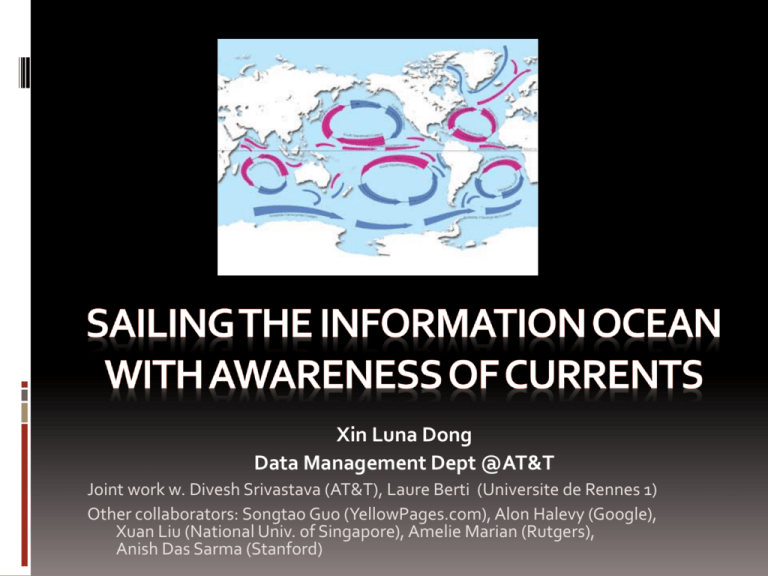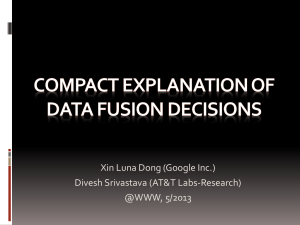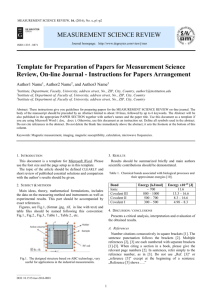Presentation - Xin Luna Dong
advertisement

Xin Luna Dong
Data Management Dept @AT&T
Joint work w. Divesh Srivastava (AT&T), Laure Berti (Universite de Rennes 1)
Other collaborators: Songtao Guo (YellowPages.com), Alon Halevy (Google),
Xuan Liu (National Univ. of Singapore), Amelie Marian (Rutgers),
Anish Das Sarma (Stanford)
The WWW is Great
A Lot of Information on the Web!
Is the Web Trustable?
When I first saw 1968 on the web page, I thought,
'Wow, apparently, all those Brady Bunch books I've
read listing 1969 as the show's first year were wrong’.
But even though I obviously trusted the Internet, I was
still kind of puzzled. So I checked other Brady Bunch
fan sites, and all of them said 1969. After a while, it
slowly began to sink in that the World Wide Web might
be tainted with unreliable information.
—Caryn Wisniewski, a Pueblo, CO, legal secretary and
diehard Brady Bunch fan [News from the Onion]
Information Can Be Erroneous (I)
7/2009
Information Can Be Erroneous (II)
7/2009
Information Can Be Out-Of-Date (I)
7/2009
Information Can Be Out-Of-Date (I)
7/2009
Information Can Be Out-Of-Date (II)
7/2009
This Might Be WhatYou See
Sometimes, Information Can Be Ahead-Of-Time
The story, marked
“Hold for release –
Do not use”, was
sent in error to the
news service’s
thousands of
corporate clients.
False Information Can Be Propagated (I)
Maurice Jarre (1924-2009) French Conductor and Composer
“One could say my life itself has been one long soundtrack.
Music was my life, music brought me to life, and music is how
I will be remembered long after I leave this life. When I die
there will be a final waltz playing in my head and that only I
can hear.”
2:29, 30 March 2009
False Information Can Be Propagated (II)
UA’s bankruptcy
Chicago Tribune, 2002
Sun-Sentinel.com
Google News
Bloomberg.com
The UAL stock
plummeted to $3
from $12.5
Wrong information
can be just as bad as
lack of information.
The Internet needs a
way to help people
separate rumor from
real science.
– Tim Berners-Lee
Why is the Problem Hard?
(A Well-Predicted Problem)
Facts and truth really don’t have
much to do with each other.
— William Faulkner
S1
S2
S3
Stonebraker
MIT
Berkeley
MIT
Dewitt
MSR
MSR
UWisc
Bernstein
MSR
MSR
MSR
Carey
UCI
AT&T
BEA
Halevy
Google
Google
UW
Why is the Problem Hard?
(A Well-Predicted Problem)
Facts and truth really don’t have
much to do with each other.
— William Faulkner
S1
S2
S3
Stonebraker
MIT
Berkeley
MIT
Dewitt
MSR
MSR
UWisc
Bernstein
MSR
MSR
MSR
Carey
UCI
AT&T
BEA
Halevy
Google
Google
UW
Naïve voting works
Why is the Problem Hard?
(A Well-Predicted Problem)
A lie told often enough becomes the
truth.
— Vladimir Lenin
S1
S2
S3
S4
S5
Stonebraker
MIT
Berkeley
MIT
MIT
MS
Dewitt
MSR
MSR
UWisc
UWisc
UWisc
Bernstein
MSR
MSR
MSR
MSR
MSR
Carey
UCI
AT&T
BEA
BEA
BEA
Halevy
Google
Google
UW
UW
UW
Naïve voting works only if data sources are independent.
Our Goal: Truth Discovery w. Awareness
of Dependence Between Sources
You can fool some of the people all the
time, and all of the people some of the
time, but you cannot fool all of the people
all the time.
– Abraham Lincoln
S1
S2
S3
S4
S5
Stonebraker
MIT
Berkeley
MIT
MIT
MS
Dewitt
MSR
MSR
UWisc
UWisc
UWisc
Bernstein
MSR
MSR
MSR
MSR
MSR
Carey
UCI
AT&T
BEA
BEA
BEA
Halevy
Google
Google
UW
UW
UW
Naïve voting works only if data sources are independent.
Challenges in Dependence Discovery
1. Sharing common data does
not in itself imply copying.
2. With only a snapshot it is hard
to decide which source is a copier.
S1
S2
S3
S4
S5
Stonebraker
MIT
Berkeley
MIT
MIT
MS
Dewitt
MSR
MSR
UWisc
UWisc
UWisc
Bernstein
MSR
MSR
MSR
MSR
MSR
Carey
UCI
AT&T
BEA
BEA
BEA
Halevy
Google
Google
UW
UW
UW
3. A copier can also provide or verify some data by
itself, so it is inappropriate to ignore all of its data.
High-Level Intuitions for Dependence Detection
Intuition I: decide dependence (w/o direction)
Let D1, D2 be data from two sources. D1 and D2 are
dependent if
Pr(D1, D2) <> Pr(D1) * Pr(D2).
Dependence?
Are Source 1 and Source 2 dependent? Not necessarily
Source 1 on USA Presidents:
Source 2 on USA Presidents:
1st : George Washington
1st : George Washington
2nd : John Adams
2nd : John Adams
3rd : Thomas Jefferson
3rd : Thomas Jefferson
4th : James Madison
4th : James Madison
…
…
41st : George H.W. Bush
41st : George H.W. Bush
42nd : William J. Clinton
42nd : William J. Clinton
43rd : George W. Bush
43rd : George W. Bush
44th: Barack Obama
44th: Barack Obama
Dependence? --Common Errors
Are Source 1 and Source 2 dependent? Very likely
Source 1 on USA Presidents:
Source 2 on USA Presidents:
1st : George Washington
1st : George Washington
2nd : Benjamin Franklin
2nd : Benjamin Franklin
3rd : Tom Jefferson
3rd : Tom Jefferson
4th : Abraham Lincoln
4th : Abraham Lincoln
…
…
41st : George W. Bush
41st : George W. Bush
42nd : Hillary Clinton
42nd : Hillary Clinton
43rd : Mickey Mouse
43rd : Mickey Mouse
44th: Barack Obama
44th: John McCain
High-Level Intuitions for Dependence Detection
Intuition I: decide dependence (w/o direction)
Let D1, D2 be data from two sources. D1 and D2 are
dependent if
Pr(D1, D2) <> Pr(D1) * Pr(D2).
Intuition II: decide copying direction
Let F be a property function of the data; e.g.,
accuracy of data. D1 is likely to be dependent on
D2 if
|F(D1 D2)-F(D1-D2)| > |F(D1 D2)-F(D2-D1)| .
Dependence? -- Different Accuracy
S1 more likely
Are Source 1 and Source 2 dependent? to be a copier
Source 1 on USA Presidents:
Source 2 on USA Presidents:
1st : George Washington
2nd : John Adams
3rd : Thomas Jefferson
1st : George Washington
2nd : Benjamin Franklin
3rd : Tom Jefferson
4th : Abraham Lincoln
4th : Abraham Lincoln
…
…
41st : George W. Bush
41st : George W. Bush
42nd : Hillary Clinton
42nd : Hillary Clinton
43rd : George W. Bush
44th: John McCain
43rd : Mickey Mouse
44th: John McCain
Outline
Motivation and intuitions for solution
For a static world [VLDB’09]
Techniques
Experimental Results
For a dynamic world [VLDB’09]
Techniques
Experimental Results
Framework of the Solomon project and
future work [CIDR’09]
Problem Definition
INPUT
Objects: an aspect of a real-world entity
E.g., director of a movie, author list of a book
Each associated with one true value
Sources: each providing values for a subset
of objects
OUTPUT: the true value for each object
Source Dependence
Source dependence: two sources S and T deriving
the same part of data directly or transitively from a
common source (can be one of S or T).
Independent source
Copier
copying part (or all) of data from other sources
may verify or revise some of the copied values
may add additional values
Assumptions
Independent values
Independent copying
No loop copying
Models for a Static World
Core case
Conditions
1.
2.
3.
Same source accuracy
Uniform false-value distribution
Categorical value
Proposition: W. independent “good” sources, Naïve voting
selects values with highest probability to be true.
Models
Consider value probabilities
in dependence analysis
Remove Cond 1
Depen
Accu
Remove Cond 3
Remove Cond 2
AccuPR
Sim
NonUni
Models for a Static World
Core case
Conditions
1.
2.
3.
Same source accuracy
Uniform false-value distribution
Categorical value
Proposition: W. independent “good” sources, Naïve voting
selects values with highest probability to be true.
Models
Consider value probabilities
in dependence analysis
Remove Cond 1
Depen
Accu
Remove Cond 3
Remove Cond 2
AccuPR
Sim
NonUni
I. Dependence Detection
Intuition I. If two sources share a lot of true
values, they are not necessarily dependent.
Different Values
Same Values
TRUE
S1 S2
I. Dependence Detection
Intuition I. If two sources share a lot of false
values, they are more likely to be dependent.
Different Values
Same Values
TRUE
FALSE
S1 S2
Bayesian Analysis – Basic
S1 S2
Different Values Od
Same Values
TRUE Ot
FALSE Of
Observation: Ф
Goal: Pr(S1S2| Ф), Pr(S1S2| Ф) (sum up to 1)
According to the Bayes Rule, we need to know
Pr(Ф|S1S2), Pr(Ф|S1S2)
Key: computing Pr(Ф(O)|S1S2), Pr(Ф(O)|S1S2)
for each OS1 S2
Bayesian Analysis – Probability Computation
S1 S2
Different Values Od
Same Values
TRUE Ot
FALSE Of
Pr
Ot
Of
Od
Independence
Dependence
2
1
c
1
(1 c)
1
2
2
2
n
n
n
Pd 1 1
2
2
n
>
c
2
n
(1 c)
Pd (1 c)
ε-error rate; n-#wrong-values; c-copy rate
II. Finding the True Value
10 sources voting for an object
Count =2
2
Count =2.14
S2 (1-.4*.8=.68)
.4
.4
S1
(1)
S5
(.682)
Count=1.44 S7
S9
.7
3
1
1
S6
1
1
S3
.4
S4
S10
S8
Order?
See paper
Models in This Paper
Core case conditions
1. Same source accuracy
2. Uniform false-value distribution
3. Categorical value
Consider value probabilities
in dependence analysis
Remove Cond 1
Depen
Accu
Remove Cond 3
Remove Cond 2
AccuPR
Sim
NonUni
III. Considering Source Accuracy
Intuition II. S1 is more likely to copy from S2, if
the accuracy of the common data is highly
different from the accuracy of S1.
Pr
Ot
Independence
1
1 c 1 2 (1 c)
2
2
Dependence
2
Of
n
n
n
Od
Pd 1 P t Pf
c
2
n
(1 c)
Pd (1 c)
III. Considering Source Accuracy
Intuition II. S1 is more likely to copy from S2, if
the accuracy of the common data is highly
different from the accuracy of S1.
Pr
Independence
S1 Copies S2
S2 Copies S1
≠
S c P (1 c)
S c P (1 c)
≠
Ot Pt 1 S1 1 S2 1 S1 c Pt (1 c) 1 S2 c Pt (1 c)
Of
Od
Pf
S1 S 2
n
Pd 1 P t Pf
1
f
Pd (1 c)
2
f
Pd (1 c)
Source Accuracy
A(S ) Avg P(v)
vV ( S )
eC (v )
P (v )
e C ( v0 )
A' ( S ) ln
v0 D ( O )
C (v)
A' (S )
SS ( v )
nA( S )
1 A( S )
Consider dependence
C (v)
A' (S ) I (S )
SS ( v )
IV. Combining Accuracy and Dependence
Step 2
Truth
Discovery
Source-accuracy
Computation
Dependence
Detection
Step 3
Step 1
Theorem: w/o accuracy, converges
Observation: w. accuracy, converges when #objs >> #srcs
The Motivating Example
S1
S2
S3
S4
S5
Stonebraker
MIT
Berkeley
MIT
MIT
MS
Dewitt
MSR
MSR
UWisc
UWisc
UWisc
Bernstein
MSR
MSR
MSR
MSR
MSR
Carey
UCI
AT&T
BEA
BEA
BEA
Halevy
Google
Google
UW
UW
UW
S1
.87
S2
.2
S4
.14
.2
.99
.99
Rnd 3
S1
S3
.99
Rnd 2
S4
S5
…
.08
S2
Rnd 11
S2
S3
.49.49 .49
.49
.49
S5
S1
.49
.49
S4
S3
.49.44 .55
.55
.44
S5
The Motivating Example
Accuracy
S1
S2
S3
S4
S5
Round 1
.52
.42
.53
.53
.53
Round 2
.63
.46
.55
.55
.55
Round 3
.71
.52
.53
.53
.37
Round 4
.79
.57
.48
.48
.31
…
…
…
…
…
…
Round 11
.97
.61
.40
.40
.21
Carey
Halevy
Value
Confidence
UCI
AT&T
BEA
Google
UW
Round 1
1.61
1.61
2.0
2.1
2.0
Round 2
1.68
1.3
2.12
2.74
2.12
Round 3
2.12
1.47
2.24
3.59
2.24
Round 4
2.51
1.68
2.14
4.01
2.14
…
…
…
…
…
…
Round 11
4.73
2.08
1.47
6.67
1.47
Experimental Setup
Dataset: AbeBooks
877 bookstores
1263 CS books
24364 listings, w. ISBN, author-list
After pre-cleaning, each book on avg has 19 listings
and 4 author lists (ranges from 1-23)
Golden standard: 100 random books
Manually check author list from book cover
Measure: Precision=#(Corr author lists)/#(All lists)
Parameters: c=.8, ε=.2, n=100
ranging the paras did not change the results much
WindowsXP, 64 2 GHz CPU, 960MB memory
Naïve Voting and Types of Errors
Naïve voting has precision .71
Error type
Missing authors
Additional authors
Mis-ordering
Mis-spelling
Incomplete names
Num
23
4
3
2
2
Contributions of Various Components
Considering dependence
improves the results most
Methods
Naïve
Only value similarity
Only source accuracy
Only source dependence
Depen+accu
Depen+accu+sim
Precision improves by
25.4% over Naïve
Prec
.71
.74
.79
.83
.87
.89
#Rnds Time(s)
1
.2
1
.2
23
1.1
3
28.3
22
185.8
18
197.5
Reasonably fast
Discovered Dependence
2916 bookstore pairs provide data on at least the
same 10 books; 508 pairs are likely to be dependent
Bookstore
#Copiers #Books
Accu
Caiman
17.5
1024
.55
MildredsBooks
14.5
123
.88
COBU
& Co. KG on
Among
all GmbH
bookstores,
THESAINTBOOKSTORE
avg each
provides 28 books;
Limelight
conforming
toBookshop
the intuition
Revaluation
Books are
that small
bookstores
Players
Quest from
more likely
to copy
AshleyJohnson
large ones
13.5
131
.91
13.5
321
.84
12
921
.54
Accuracy1091
not very high;
12
.76
applying Naïve
obtains
11.5
212
.82
precision of
11.5
77 only .58 .79
Powell’s Books
11
547
.55
AlphaCraze.com
10.5
157
.85
Avg
12.8
460
.75
Computed Source Accuracy
46 bookstores provide data on more than 10 books
in the golden standard
Avg accu
Avg diff
Sampled
.542
-
Only Accuracy
.623
.096
Depen+Accu
.614
.087
Depen+Accu+Sim
.607
.082
Considering dependence
makes improvement
Effective in computation
of source accuracy
Outline
Motivation and intuitions for solution
For a static world [VLDB’09]
Techniques
Experimental Results
For a dynamic world [VLDB’09]
Techniques
Experimental Results
Framework of the Solomon project and
future work [CIDR’09]
Challenges for a Dynamic World
S1
S2
S3
S4
S5
Stonebraker
MIT
UCB
MIT
MIT
MS
Dewitt
MSR
MSR
Wisc
Wisc
Wisc
Bernstein
MSR
MSR
MSR
MSR
MSR
Carey
UCI
AT&T
BEA
BEA
BEA
Halevy
Google
Google
UW
UW
UW
Challenges for a Dynamic World
Stonebraker
S1
S2
S3
S4
S5
(03, MIT)
(00, UCB)
(01, UCB)
(06, MIT)
(05, MIT)
(00, UW)
(01, Wisc)
(08, MSR)
(01, UW)
(02, Wisc)
(05, Wisc)
(03, UCB)
(05, MS)
ERR!
(03, UW)
(05, )
(07, Wisc)
(Ѳ, UCB), (02, MIT)
Dewitt
(Ѳ, Wisc), (08, MSR)
Out-of-date!
(00, Wisc)
(09, MSR)
Out-of-date!
Out-of-date!
Bernstein (Ѳ, MSR)
(00, MSR)
(00, MSR)
(01, MSR)
(07, MSR)
(03, MSR)
Carey (Ѳ, Propell),
(04, BEA)
(09, UCI)
(05, AT&T)
ERR!
(06, BEA)
(07, BEA)
(07, BEA)
Out-of-date!
Out-of-date! Out-of-date!
(00, UW)
(07, Google)
(00, Wisc)
(02, UW)
(05, Google)
(01, Wisc)
(06, UW)
(05, UW)
(02, BEA), (08, UCI)
Halevy
(Ѳ, UW), (05, Google)
SLOW!
SLOW!
(03, Wisc)
(05, Google)
(07, UW)
SLOW!
1.
2.
3.
True values can evolve over time
Low-quality data can be caused by different reasons
Copying relationship can evolve over time as well
Challenges for a Dynamic World
S1
S2
S3
S4
S5
(03, MIT)
(00, UCB)
(01, UCB)
(06, MIT)
(05, MIT)
(03, UCB)
(05, MS)
(00, UW)
(01, Wisc)
(08, MSR)
(01, UW)
(02, Wisc)
(05, Wisc)
(Ѳ, Wisc), (08, MSR)
(00, Wisc)
(09, MSR)
(03, UW)
(05, )
(07, Wisc)
Bernstein (Ѳ, MSR)
(00, MSR)
(00, MSR)
(01, MSR)
(07, MSR)
(03, MSR)
Carey (Ѳ, Propell),
(04, BEA)
(09, UCI)
(05, AT&T)
(06, BEA)
(07, BEA)
(07, BEA)
(00, UW)
(07, Google)
(00, Wisc)
(02, UW)
(05, Google)
(01, Wisc)
(06, UW)
(05, UW)
(03, Wisc)
(05, Google)
(07, UW)
Stonebraker
(Ѳ, UCB), (02, MIT)
Dewitt
(02, BEA), (08, UCI)
Halevy
(Ѳ, UW), (05, Google)
S1
S2
.49
S4
S1
S3
.49.44 .55
.55
.44
S5
S2
(05-now)
S4
(06-now)
S3
(03, 07)
(00-05)
S5
Problem Definition
Problem
Definition
Static World
Objects
Each associated with a
value; e.g., Google for
Halevy
Each associated with a lifespan;
e.g., (00, UW), (05, Google) for
Halevy
Sources
Each can provide a
value for an object;
e.g., S1 providing
Google
Each can have a list of updates
for an object; e.g., S1’s updates
for Halevy (00, UW), (07, Google)
true value for each
object
1. Life span: true value for each
object at each time point
2. Copying: pr of S1 is a copier of
S2 and pr of S1 being actively
copying at each time point
OUTPUT
Dynamic World
Contributions
I.
II.
III.
IV.
Quality measures of data sources
Dependence detection (HMM model)
Lifespan discovery (Bayesian model)
Considering delayed publishing
I. Quality of Data Sources
Three orthogonal quality measures
Exact
ness
Cove
rage
CEF-measure
Fresh
ness
Coverage: how many transitions are captured
Exactness: how many transitions are not mis-captured
Freshness: how quickly transitions are captured
Accuracy
Mis-capturable
Wisc Capturable
Dewitt
Mis-capturable
Capturable
Mis-capturable
Mis-capturable
Mis-capturable
Capturable
MSR Capturable
Ѳ(2000)
2008
UW
S5
Mis-captured
2003
Mis-captured
2005
Wisc
Captured
2007
Coverage = #Captured/#Capturable (e.g., ¼=.25)
Exactness= 1-#Mis-Captured/#Mis-Capturable (e.g., 1-2/5=.6)
Freshness()= #(Captured w. length<=)/#Captured (e.g., F(0)=0, F(1)=0, F(2)=1/1 = 1…)
II. Copying Detection
Review of HMM model
II. Transition prs
I. Init prs
S1
.4
…
…
Sn
.3
Pr
S1
…
Sn
S1
.3
…
.55
…
…
…
…
Sn
.6
…
.2
Statet0
Statet1
Statet2
Observationt0
Observationt1
Observationt2
III. Observation prs
Pr
O1
…
On
S1
.9
…
.05
…
…
…
…
Sn
.2
…
.4
•Forward-backward inference to
decide pr of each state at each time
•Baum-Welch for parameter learning
The Copying-Detection HMM Model
ftc
C1c (S1 as an
active copier)
(1-ti)/2
pri=
ti
f
pri= (1-)/2
(1-tc)ti
I (S1 and S2
independent)
(1-f)tc
1-f
C1~c (S1 as an
idle copier)
pri= 0
(1-tc)(1-ti) (1-tc)(1-ti)
(1-tc)ti
(1-ti)/2
pri= 0
pri= (1-)/2
C2c (S2 as an
active copier)
ftc
f
(1-f)tc
C2~c (S2 as an
idle copier)
A period of copying starts from and ends with a real copying.
Parameters:
1-f
– Pr(init independence) ; f – Pr(a copier actively copying);
ti – Pr(remaining independent); tc – Pr(remaining as a copier);
Observation Probability (I)
A huge number of possible observations, so we
need an equation to compute probability
Intuition II. If S1 and S2 are dependent, S1 is
likely to be a copier if its updates often follow S2’s
On the other hand, if S1’s updates often follow
S2’s, S1 is not necessarily a copier of S2.
Observation Probability (II)
Intuition I. S1 and S2 are likely to be dependent if
common mistakes
overlapping updates are performed after the real values have already changed
low coverage but highly overlapping updates in a close time frame
S1
S2
S3
S4
S5
(03, MIT)
(00, UCB)
(01, UCB)
(06, MIT)
(05, MIT)
(03, UCB)
(05, MS)
(00, UW)
(01, Wisc)
(08, MSR)
(01, UW)
(02, Wisc)
(05, Wisc)
(00, Wisc), (08, MSR)
(00, Wisc)
(09, MSR)
(03, UW)
(05, )
(07, Wisc)
Bernstein (00, MSR)
(00, MSR)
(00, MSR)
(01, MSR)
(07, MSR)
(03, MSR)
Carey (00, Propell),
(04, BEA)
(09, UCI)
(05, AT&T)
(06, BEA)
(07, BEA)
(07, BEA)
(00, Wisc)
(02, UW)
(05, Google)
(01, Wisc)
(06, UW)
(05, UW)
(03, Wisc)
(05, Google)
(07, UW)
Stonebraker
(00, UCB), (02, MIT)
Dewitt
(02, BEA), (08, UCI)
Halevy
(00, UW)
(00, UW), (05, Google) (07, Google)
Observation Probability (III)
S2’s updates since S1’s last “copying”
U~S1, S2
US1, S2
US1, ~S2
S1’s updates
Pr
US1,~S2
O(transition)
S1 not copying S2
V0
V0’
tr
tr'
(O,V)
S1(update)
t
S1 copying S2
Pc (U)
US1,S2
E ( S1 )C ( S1 ) F ( S1 , t tr ) U true
P(U )
1 E ( S1 )
U false
n
s+(1-s)Pc(U)
U~S1, S2
1-P(U)
(1-s)(1-Pc(U))
n – #(wrong values); s – selectivity
P (U) – similar to P(U) but use independent CEF-measure
III. Lifespan Discovery
Algorithm: for each object O
Decide the initial
value v0
(Bayesian model)
Terminate when no
more transition
Decide the next
transition (t,v)
(Bayesian model)
(Details in the paper)
Iterating Dependence Detection and
Lifespan Discovery
Step 2
Lifespan
Discovery
CEF-measure
Computation
Dependence
Detection
Step 1
Step 3
Typically converges when #objs >> #srcs.
The Motivating Example
S1
S2
(06-now)
S3
(00-05)
(05-now)
(03, 07)
S4
S5
Copying probability bet S5 vs. S3
03
04
05
06
07
08
09
Copy (C1c)
1
.43
.02
.43
1
.39
.12
Idle (C1~c)
0
.51
.89
.51
0
.35
.52
Sum
1
.94
.91
.94
1
.74
.64
The Motivating Example
Halevy
(Ѳ, UW), (05, Google)
S1
S2
S3
S4
S5
(00, UW)
(07, Google)
(00, Wisc)
(02, UW)
(05, Google)
(01, Wisc)
(06, UW)
(05, UW)
(03, Wisc)
(05, Google)
(07, UW)
Lifespan for Halevy and CEF-measure for S1 and S2
Rnd
Halevy
C(S1)
E(S1)
F(S1,0)
F(S1,1)
C(S2)
E(S2)
F(S2,0)
F(S2,1)
.99
.95
.1
.2
.99
.95
.1
.2
1
(Ѳ, Wisc)
(2002, UW)
(2003, Google)
.97
.94
.27
.4
.57
.83
.17
.3
2
(Ѳ, UW)
(2002, Google)
.92
.99
.27
.4
.64
.8
.18
.27
3
(Ѳ, UW)
(2005, Google)
.92
.99
.27
.4
.64
.8
.25
.42
0
Experimental Setup
Dataset: Manhattan restaurants
Data crawled from 12 restaurant websites
8 versions: weekly from 1/22/2009 to 3/12/2009
5269 restaurants, 5231 appearing in the first crawling and
5251 in the last crawling
467 restaurants deleted from some websites, 280 closed
before 3/15/2009 (Golden standard)
Measure: Precision, Recall, F-measure
G: really closed restaurants; R: detected closed restaurants
P
GR
R
,R
GR
G
2 PR
,F
PR
Parameters: s=.8, α=f=.5, ti=tc=.99, n=1 (open/close)
WindowsXP, 64 2 GHz CPU, 960MB memory
Contributions of Various Components
Naïve missed a lot of restaurants.
Method
Ever-existing
Applying rules is inadequate.
Closed
#Rnds
Time(s)
#Rest
Prec
Rec
F-msr
ALL
-
.60
1.0
.75
-
-
ALL2
-
.94
.34
.50
-
-
Naïve
1192
.70
.93
.80
1
158
CEF
5068
.83
.88
.85
7
637
CopyCEF
5186
.86
.87
.86
6
1408
Google
-
.84
.19
.30
-
-
CEF and CopyCEF obtain
High precision and recall
Google Map lists a lot of outof-business restaurants
Computed CEF-Measure
Sources
Coverage
Exactness
Freshness
#Closed-rest
MenuPages
.66
.98
.85
35
TasteSpace
.44
.97
.30
123
NYMagazine
.43
.99
.52
69
NYTimes
.44
.98
.38
75
ActiveDiner
.44
.96
.93
81
TimeOut
.42
.996
.64
45
SavoryCities
.26
.99
.42
34
VillageVoice
.22
.94
.40
47
FoodBuzz
.18
.93
.36
65
NewYork
.14
.92
.43
34
OpenTable
.12
.92
.40
11
DiningGuide
.1
.90
.10
52
GoogleMaps
-
-
-
228
Discovered Dependence
12 out of 66 pairs are likely to be dependent
TasteSpace
NYTimes
NewYork
FoodBuzz
TimeOut
OpenTable
VillageVoice
MenuPages
DiningGuide
ActiveDiner
NYMagazine
SavoryCities
Outline
Motivation and intuitions for solution
For a static world [VLDB’09]
Techniques
Experimental Results
For a dynamic world [VLDB’09]
Techniques
Experimental Results
Framework of the Solomon project and
future work [CIDR’09]
Data Integration Faces 3 Challenges
Data Conflicts
Instance Heterogeneity
Structure Heterogeneity
Data Integration Faces 3 Challenges
Data Conflicts
Instance Heterogeneity
Structure Heterogeneity
Data Integration Faces 3 Challenges
Scissors
Paper Scissors
Data Conflicts
Instance Heterogeneity
Structure Heterogeneity
Data Integration Faces 3 Challenges
Scissors
Glue
Data Conflicts
Instance Heterogeneity
Structure Heterogeneity
Existing Solutions Assume Independence of
Data Sources
Data Conflicts
Instance Heterogeneity
Assume INDEPENDENCE
of data sources
•Data fusion
•Truth
discovery
Structure Heterogeneity
•String matching (edit distance,
token-based, etc.)
•Object matching (aka. record
linkage, reference reconciliation, …)
•Schema matching
•Model management
•Query answering using views
•Information extraction
Source Dependence Adds A New Dimension to
Data Integration
Data
Fusion
Record
Linkage
• Truth discovery
• Integrating probabilistic
data
• Improve record linkage
• Distinguish bet wrong values
and alter representations
• Query optimization
• Improve schema
Answering
matching
Query
Source • Recommend trustworthy ,
up-to-date, and
Recomindependent sources
mendation
Data Conflicts
Instance Heterogeneity
Structure Heterogeneity
ResearchAgenda:
Discovery
• Discovery of copying for
snapshots of data
• Discovery of copying for
update history
• Discovery of opinion
influence in reviews
• Visualization of dependence
relationship
• …
•
•
•
Applications •
•
Truth discovery
Record linkage
Query optimization
Source recommendation
…
Solomon
Data Conflicts
Instance Heterogeneity
Structure Heterogeneity
Related Work
Data provenance [Buneman et al., PODS’08]
Focus on effective presentation and retrieval
Assume knowledge of provenance/lineage
Opinion pooling [Clemen&Winkler, 1985]
Combine pr distributions from multiple experts
Again, assume knowledge of dependence
Detect plagiarism of programs [Schleimer,
Sigmod’03]
Unstructured data
Bayesian Analysis – Properties
The probability of dependence increases in three
cases.
Different Values
Same Values
TRUE
FALSE
S1 S2
II. Vote Count w. Probabilistic Dependence
S2
S1
S2
S3 S1
S2
S3
S1
S2
Pr = (1-.4)^3=.216
Vote count = 3
S1
S3
S2
S3 S1
S2
S1
S2
Pr = .4*.6^2=.144
Vote count = 1+1+.2
S1
S3
Pr = .4^3=.096
Vote count
= 1+.2+.2^2=1.24
S3
S2
S3
S1
S3
Pr = .4^2*.6=.096
Vote count = ?
II. Vote Count w. Probabilistic Dependence
S2
S1
S2
S3
Vote count
= 1+.2+.2=1.4
Pr = .32*.096=.03
S1
S2
S3 S1
Vote count
= 1+.2+.2=1.24
Pr = .32*.096=.03
S2
S3
Vote count
= 1+.2+.2=1.4
Pr = .32*.096=.03
S1
S3
Vote count
= 1+1+.2^2=2.04
Pr = .04*.096=.004
III. Algorithm
Challenge: inter-dependence between truth
discovery and dependence detection
Solution: VOTE
Iteratively compute dependence probability and
decide true values
Important to consider dependence from the
beginning
Theorem: VOTE converges in at most 2ln0 rounds.
l - #obj; n0 – max{#values for an object}
An Example
S1
S2
S3
S4
S5
Stonebraker
MIT
Berkeley
MIT
MIT
MS
Dewitt
MSR
MSR
UWisc
UWisc
UWisc
Bernstein
MSR
MSR
MSR
MSR
MSR
Carey
UCI
AT&T
BEA
BEA
BEA
Halevy
Google
Google
UW
UW
UW
S1
.87
S2
.2
.2
S4
S3
.99
.99
.99
S5
Carey
Round 1
Halevy
UCI
AT&T
BEA
Google
UW
1
1
1.24
1.3
1.24
An Example
S1
S2
S3
S4
S5
Stonebraker
MIT
Berkeley
MIT
MIT
MS
Dewitt
MSR
MSR
UWisc
UWisc
UWisc
Bernstein
MSR
MSR
MSR
MSR
MSR
Carey
UCI
AT&T
BEA
BEA
BEA
Halevy
Google
Google
UW
UW
UW
S1
S1
.87
S2
.2
S4
.18
.2
S2
S3
.99
.99
.99
.99
.97
S4
S5
Carey
S3
.97
S5
Halevy
UCI
AT&T
BEA
Google
UW
Round 1
1
1
1.24
1.3
1.24
Round 2
1
1
1.25
1.85
1.25




